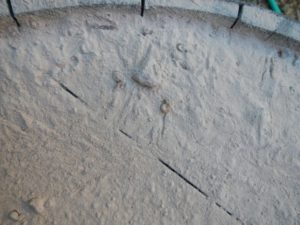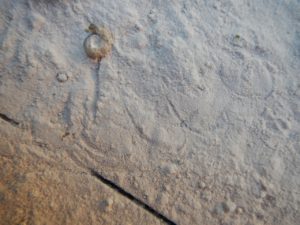Many animals do not leave tracks in easy to read substrates such as sand and mud. Some animals climb trees, swim under water, or fly in the air. Other animals burrow under the ground or slide across it on a mucous-lubricated peristaltic stomach-foot (snails and slugs).
Are these animals impossible to track?
I take a holistic approach to tracking and would argue that everything leaves tracks including fish in water, birds in the air, and slippery slugs. It is often necessary to change your perspective or think outside the box to see or infer these “tracks.”
I recently wanted to see the tracks of a bird that I have never seen walking on the ground. It is a common bird that prefers to perch on branches or fences, flying out to catch insects on the wing. There were a couple popular perch spots near my house and I decided to create “tracking traps” on these spots. I simply sprinkled some fine dust on the flat surfaces (cheap white flour works well (unless the animals are gluten-intolerant)).
Luckily one of the perches was on the edge of a wine barrel so there was plenty of flat space to put the dust. I knew the bird perched on the very rim of the barrel. I tried to get dust on the rim but I also hoped that the bird might venture a footstep or two onto the flat area.
Immediately, the dust began recording interesting information. A variety of marks were being made in the dust, some clearer than others. One added benefit was I could tell which scats were new because they were on top of the dust.
While I have yet to get the footprints that I hoped for I did get some perhaps more interesting and important tracks. Tracks are not only made by feet and in this case the tracks appear to be made by the other set of appendages that birds have, the ones they fly with. Look closely at the photo to see the marks left by an extended wing. You can even see the individual ridges on the feathers if you look closely.
This experience has several embedded lessons:
First, all animals leave tracks. They might be vortices of air or thermal disturbances that we usually can not see. Or they might not be what we think of as tracks and we might not know how to interpret the pattern.
Second, you can manipulate the environment to accelerate your learning. You don’t have to travel 50 miles to sand dunes or riparian areas that have the best substrates for tracking. You can sprinkle flour or rake out a good spot of dirt in your yard.
Third, be prepared to notice and learn what you weren’t expecting. Even though I was hoping to get footprint tracks I got something else. If I had been so fixed on seeing footprints I might have missed the subtle tracks left by the bird’s wing. Often times this unexpected lesson is the thing you really need to learn about more than the thing you were looking for.
Guessing Game: If you think you know your bird scat and habits try to guess what species this is. I will reveal the answer in a future post





One Response
For those of you who are interested. The bird in question was a Black Phoebe, Sayornis nigricans. I am not that good at digital tracking (or countertracking) so I didn’t realize that the photos show the answer in the title…DOh!